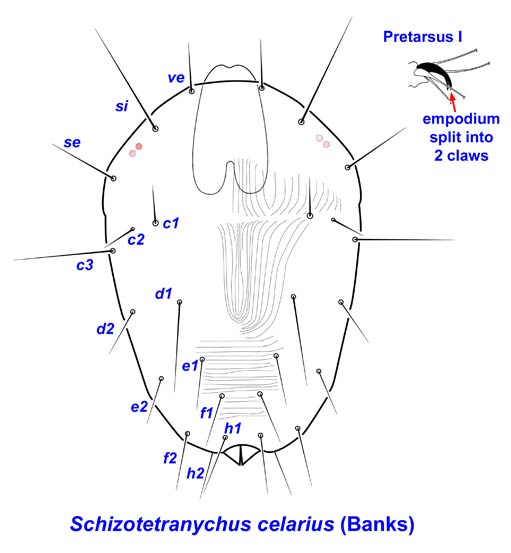Schizotetranychus
Superfamily Tetranychoidea
Family Tetranychidae
Subfamily Tetranychinae
Tribe Tetranychini
Genus Schizotetranychus
Common names: Bamboo spider mite
Probability of Encounter: Very high
Quarantine importance: High. About 140 species of Schizotetranychus have been described and many of these feed on grasses, especially bamboos, and other monocots. Figs, a variety of trees, and some herbs are also host to species of the genus.
-
Schizotetranychus andropogoni (Hirst) attacks rice, sorghum, sugarcane and other grasses. It is not currently reported from the USA, but is in Mexico, Pakistan, India, Thailand, and some countries of the former Soviet Union.
-
Schizotetranychus aspargai (Oudemans) is a pest of asparagus, pineapple, and some acacias in Australia, Europe, the Middle East, South Africa, and the USA including Hawaii and Puerto Rico.
-
Schizotetranychus baltazari Rimando attacks citrus, some ornamental shrubs, and yams and is currently known only from India, Southeast Asia, and the Philippines.
-
Schizotetranychus celarius (Banks) attacks several genera of bamboo, rice, sugarcane, other grasses, and figs. It is present in the USA including Hawaii and also found in Australia, Asia including Japan, and Europe.

Diagnosis:
-
With 2 pair of paranal setae (h2-3) and 2 pairs of anal setae.
-
Empodium split distally into 2 claws.
-
Tarsus I with 2 pairs of closely associated duplex setae.
-
Opisthosoma with 10 pairs of 'dorsal' setae (c1-3, d1-2, e1-2, f1-2, h1).
Similar taxa. Several generic-level taxa similar to Schizotetranychus in having split claw-like empodia have been recently described from bamboos (e.g. Yunonychus, Yezonychus) based on the absence of an opisthosomal setal pair (i.e. 9 vs 10 pairs in Schizotetranychus); however, the identity of these setae is difficult to determine. Trilobonychus from Nothofagus in New Zealand has 3-pronged claw-like empodia and 9 pairs of opisthonotal setae (f2 absent). Other Tetranychinae lack the split empodial claw.
References
Baker EW & AE Pritchard. 1960. The tetranychoid mites of Africa. Hilgardia 29(11): 455-574.
Baker EW & DM Tuttle. 1994. A guide to the spider mites (Tetranychidae) of the United States. Indira Pub. House, West Bloomfield, MI: 347 pp.
Bolland HR, J Gutierre & CHW Flechtmann. 1998. World Catalogue of the Spider Mite Family (Acari: Tetranychidae). Brill: Leiden.
Helle W & MW Sabelis (eds.) 1985. Spider Mites, Their Biology, Natural Enemies, and Control, vol. 1A. Elsevier: New York.
Jeppson LR, HH Keifer & EW Baker. 1975. Mites Injurious to Economic Plants, University of California Press: Berkeley
Meyer, M.K.P. 1974. A revision of the Tetranychidae of Africa (Acari) with a key to the genera of the world. Dept. Agr. Tech. Serv. Mem. 36: 291 pp.
Meyer, M.K.P. Smith 1987. African Tetranychidae (Acari: Prostigmata) - with reference to the world genera. S. Afr. Dept. Agr. Water Supply, Entomol. Mem. No. 69: 175 pp.
Mignon A & CHW Flechtmann 2004. First additions and corrections to the World Catalogue of the Spider Mite Family (Acari: Tetranychidae). Intern. J. Acarol. 30: 143-152.
Ochoa R, H Aguilar & C Vargas 1994. Phytophagous Mites of Central America: An Illustrated Guide CATIE, Turrialba, Costa Rica.
Tseng Y-H 1990. A monograph of the mite family Tetranychidae (Acarina: Trombidiformes) from Taiwan. Taiwan Museum Special Publication series 9. 224 pp.
Zhang Z-Q. 2003. Mites of greenhouses: identification, biology and control. CABI Publishing, Wallingford: 244 pp.
Zhang Z-Q, Y Zhang & J Lin 2000. Mites of Schizotetranychus (Acari: Tetranychidae) from moso bamboo in Fujian, China. Syst. Appl. Acarol. Sp. Publ. 4: 19-35.
Zhang Z-Q & NA Martin 2001. A review of Schizotetranychus-like mites from New Zealand. J. Roy. Soc. N.Z. 31: 307-325.